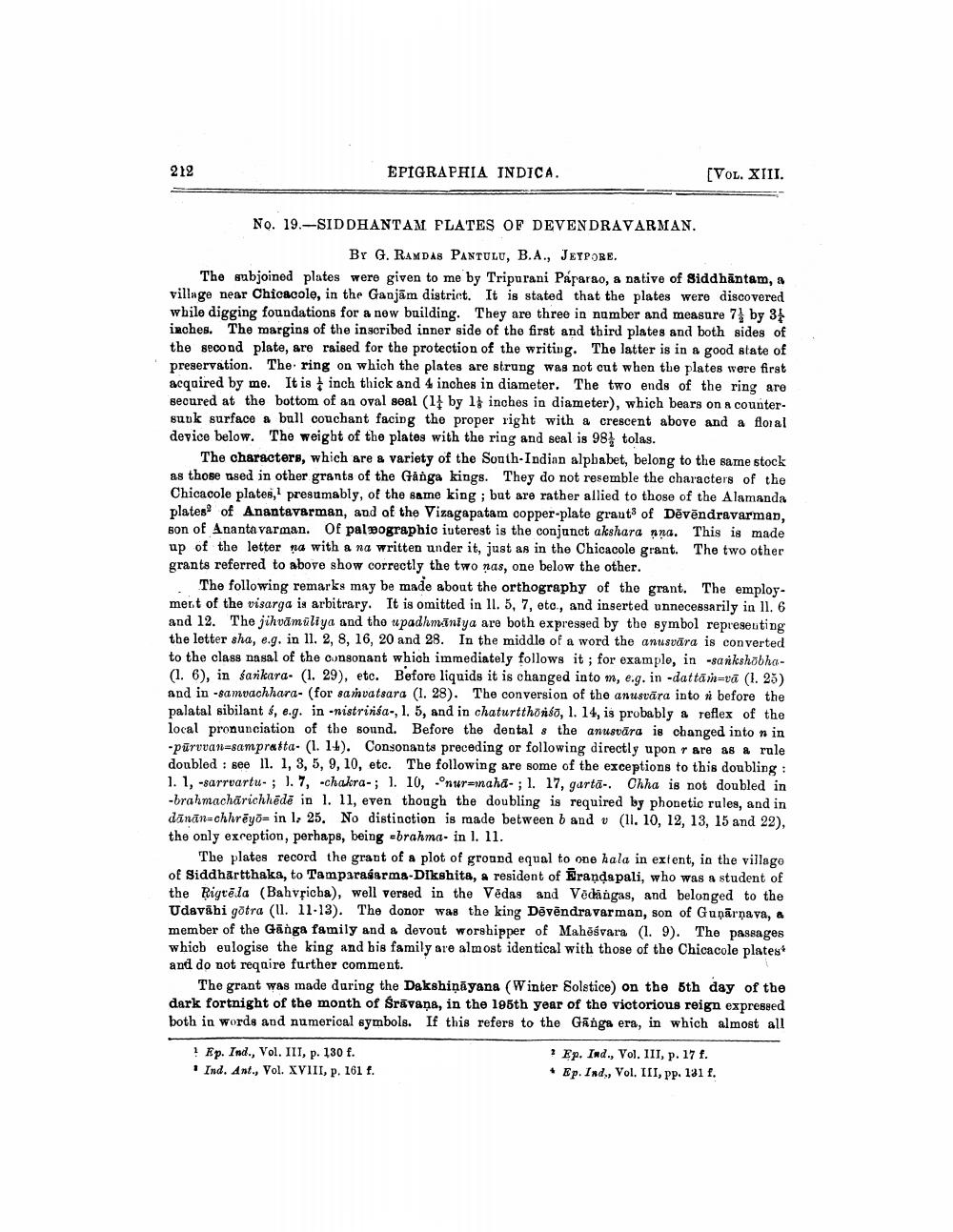________________
212
EPIGRAPHIA INDICA.
[VOL. XIII.
No. 19.--SIDDHANTAM FLATES OF DEVENDRAVARMAN.
By G. RAMDAS PANTULU, B.A., JETPORE. The subjoined plates were given to me by Tripurani Paparao, a native of Siddhantam, a village near Chicacole, in the Ganjām district. It is stated that the plates were discovered while digging foundations for a new building. They are three in number and measure 7 by 3 inches. The margins of the inscribed inner side of the first and third plates and both sides of the second plate, are raised for the protection of the writing. The latter is in a good state of preservation. The ring on which the plates are strong was not cut when the plates were first acquired by me. It is inch thick and 4 inches in diameter. The two ends of the ring are secured at the bottom of an oval seal (1 by 1} inches in diameter), which bears on a countersuvk surface a bull couchant facing the proper right with a crescent above and a floral device below. The weight of the plates with the ring and seal is 98% tolas.
The characters, which are a variety of the South Indian alphabet, belong to the same stock as those used in other grants of the Ganga kings. They do not resemble the characters of the Chicacole plates, presumably, of the same king ; but are rather allied to those of the Alamanda plates of Anantaverman, and of the Vizagapatam copper-plate grants of Dēvēndravarman, son of Ananta varman. Of palæographic iuterest is the conjunct akshara nna. This is made up of the letter na with a na written under it, just as in the Chicacole grant. The two other grants referred to above show correctly the two nas, one below the other.
The following remarks may be made about the orthography of the grant. The employmert of the visarga is arbitrary. It is omitted in 11. 5, 7, etc., and inserted unnecessarily in 11. 6 and 12. The jihvămūliya and tho upadhmīniya are both expressed by the symbol representing the letter sha, e.g. in 11. 2, 8, 16, 20 and 28. In the middle of a word the anusvära is converted to the class nasal of the consonant which immediately follows it ; for example, in -sankshobha(1. 6), in sarkara. (1. 29), etc. Before liquids it is changed into m, e.g. in -dattām=rā (1. 25) and in-samvachhara- (for samvatsara (1. 28). The conversion of the anustāra into a before the palatal sibilant $, e.g. in-nistrinsa-, 1, 5, and in chaturtthoriso, 1. 14, is probably a reflex of the local pronunciation of the sound. Before the dental & the anusvāra is changed into n in -Pūruvan-sampratta- (1. 16). Consonants preceding or following directly upon r are as a rule doubled : Bee 11. 1, 3, 5, 9, 10, etc. The following are some of the exceptions to this doubling : 1. 1, -sarruartu- ; ). 7, -chakra- ; 1. 10, Onur=maha- ; 1. 17, gartā- Chha is not doubled in -brahmachūrichhēdē in l. 11, even though the doubling is required by phonetic rules, and in dīnān=chhreyõ= in l, 25. No distinction is made between b and v (II. 10, 12, 13, 15 and 22), the only exception, perhaps, being brahma. in l. 11.
The plates record the grant of a plot of ground equal to one hala in extent, in the village of Siddhartthaka, to Tamparasarma-Dikshita, a resident of Eranda pali, who was a student of the Rigtēla (Bahvpicha), well versed in the Vedas and Vēdārgas, and belonged to the Udavābi götra (u. 11-13). The donor was the king Dēvēndravarman, son of Guņārņava, a member of the Ganga family and a devout worshipper of Mahēśvara (1. 9). The passages whicb eulogise the king and his family are almost identical with those of the Chicacole plates and do not require further comment.
The grant was made during the Dakshiņāyana (Winter Solstice) on the 5th day of the dark fortnight of the month of Srāvana, in the 195th year of the victorious reign expressed both in words and numerical symbols. If this refers to the Ganga era, in which almost all
? Ep. Ind., Vol. III, p. 130 f.
Ind. Ant., Vol. XVIII, p. 161 f.
1 Ep. Ind., Vol. III, p. 17 f. • Ep. Ind., Vol. III, pp. 131 f.




